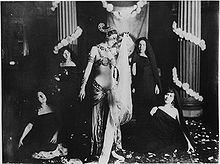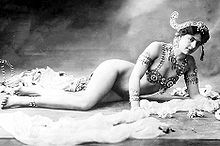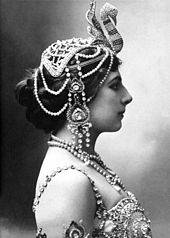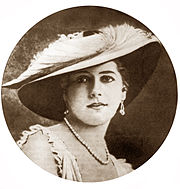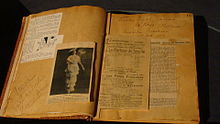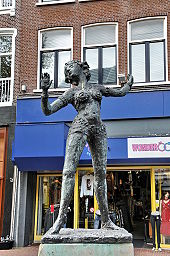- Mata Hari
-
For other uses, see Mata Hari (disambiguation).
Mata Hari 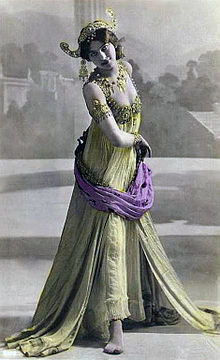
Mata Hari on a 1906 postcardBorn Margaretha Geertruida Zelle
7 August 1876
Leeuwarden, NetherlandsDied 15 October 1917 (aged 41)
Vincennes, Paris, FranceCause of death Execution by firing squad Nationality Dutch Other names Mata Hari Spouse Rudolf John MacLeod (1895-1903) Children Norman-John MacLeod
Jeanne-Louise MacLeodMata Hari was the stage name of Margaretha Geertruida "M'greet" Zelle (7 August 1876, Leeuwarden - 15 October 1917, Vincennes), a Dutch exotic dancer, courtesan, and accused spy[1] who was executed by firing squad in France under charges of espionage for Germany during World War I.[2]
Contents
Early life
Margaretha Geertruida Zelle was born in Leeuwarden, Friesland, in the Netherlands, the eldest of four children of Adam Zelle (2 October 1840, Leeuwarden - 13 March 1910, Amsterdam) and first wife (m. Franeker, 4 June 1873) Antje van der Meulen (21 April 1842, Franeker - 9 May 1891, Leeuwarden).[3] She had three brothers. Her father owned a hat store, made successful investments in the oil industry, and became affluent enough to give Margaretha a lavish early childhood[4] that included exclusive schools until the age of 13.[5]
However, Margaretha's father went bankrupt in 1889, her parents divorced soon thereafter, and Margaretha's mother died in 1891.[4][5] Her father remarried in Amsterdam on 9 February 1893 to Susanna Catharina ten Hoove (11 March 1844, Amsterdam - 1 December 1913, Amsterdam), with whom he had no children. The family had fallen apart and Margaretha moved to live with her godfather, Mr. Visser, in Sneek. In Leiden, she studied to be a kindergarten teacher, but when the headmaster began to flirt with her conspicuously, she was removed from the institution by her offended godfather.[4][5][6] After only a few months, she fled to her uncle's home in The Hague.[6]
Dutch East Indies
At 18, Margaretha answered an advertisement in a Dutch newspaper placed by a man looking for a wife. Margaretha married Dutch Colonial Army Captain Rudolf MacLeod (1 March 1856, Heukelum - 9 January 1928, Velp) in Amsterdam on 11 July 1895. He was the son of Captain John Brienen MacLeod (a descendant of the Gesto branch of the MacLeods of Skye) and Dina Louisa Baroness Sweerts de Landas. This was significant as because of this marriage she moved into the Dutch upper class and her finances were placed on a sound footing. They moved to the island of Java in the Dutch East Indies (at the time it was a Dutch colony) and had two children, Norman-John MacLeod (30 January 1897, Amsterdam - 27 June 1899) and Louise Jeanne MacLeod (Malang, Java 2 May 1898 - Velp, The Netherlands 10 August 1919).
The marriage was an overall disappointment.[7] MacLeod appears to have been an alcoholic who would take out his frustrations on his wife, who was twenty years younger, and whom he blamed for his lack of promotion. He also openly kept both a native wife and a concubine. The disenchanted Margaretha abandoned him temporarily, moving in with Van Rheedes, another Dutch officer. For months, she studied the Indonesian traditions intensively, joining a local dance company. In 1897, she revealed her artistic name: Mata Hari, Malay for "sun" (literally, "eye of the day"), via correspondence to her relatives in Holland.[5]
At MacLeod's urging, Margaretha returned to him although his aggressive demeanour hadn't changed. She escaped her circumstances by studying the local culture.[5] In 1899, their children fell violently ill from complications relating to the treatment of syphilis contracted from his parents, though the family claimed he was poisoned by an irate servant. Jeanne survived, but Norman died. Some sources[5] maintain that one of Rudolf's enemies may have poisoned a supper to kill both of their children. After moving back to the Netherlands, the couple separated in 1902 and divorced in 1907. Margaretha initially retained custody of Jeanne, but after Rudolf deliberately reneged on a support payment, Margaretha was forced to give Jeanne back to him. Jeanne later died at the age of 21, also possibly from complications relating to syphilis).[8][6]
Paris
In 1903, Margaretha moved to Paris, where she performed as a circus horse rider, using the name Lady MacLeod, much to the disapproval of the Dutch MacLeods. Struggling to earn a living, she also posed as an artist's model.
By 1905, she began to win fame as an exotic dancer. It was then that she adopted the stage name Mata Hari. She was a contemporary of dancers Isadora Duncan and Ruth St. Denis, leaders in the early modern dance movement, which around the turn of the 20th century looked to Asia and Egypt for artistic inspiration. Critics would later write about this and other such movements within the context of orientalism. Gabriel Astruc became her personal booking agent.[5]
Promiscuous, flirtatious, and openly flaunting her body, she captivated her audiences and was an overnight success from the debut of her act at the Musée Guimet on 13 March 1905.[9] She became the long-time mistress of the millionaire Lyon industrialist Émile Étienne Guimet, who had founded the Musée. She posed as a Java princess of priestly Hindu birth, pretending to have been immersed in the art of sacred Indian dance since childhood. She was photographed numerous times during this period, nude or nearly so. Some of these pictures were obtained by MacLeod and strengthened his case in keeping custody of their daughter.
She brought this carefree provocative style to the stage in her act, which garnered wide acclaim. The most celebrated segment of her act was her progressive shedding of clothing until she wore just a jeweled bra and some ornaments upon her arms and head.[5] She was seldom seen without a bra as she was self-conscious about being small-breasted. She wore a bodystocking for her performances that was similar in color to her own skin.[6]
Although her claims about her origins were fictitious, this was common practice for entertainers of that era. Her act was spectacularly successful because it elevated exotic dance to a more respectable status, and so broke new ground in a style of entertainment for which Paris was later to become world famous. Her style and her free-willed attitude made her a very popular woman, as did her eagerness to perform in exotic and revealing clothing. She posed for provocative photos and mingled in wealthy circles. At the time, as most Europeans were unfamiliar with the Dutch East Indies and thus thought of Mata Hari as exotic, it was assumed her claims were genuine.
By about 1910, myriad imitators had arisen. Critics began to opine that the success and dazzling features of the popular Mata Hari was due to cheap exhibitionism and lacked artistic merit. Although she continued to schedule important social events throughout Europe, she was held in disdain by serious cultural institutions as a dancer who did not know how to dance.[5]
Mata Hari was also a successful courtesan, though she was known more for her sensuality and eroticism rather than for striking classical beauty. She had relationships with high-ranking military officers, politicians, and others in influential positions in many countries, including Frederick William Victor Augustus Ernest, the German crown prince,[citation needed] who paid for her luxurious lifestyle.
Her relationships and liaisons with powerful men frequently took her across international borders. Prior to World War I, she was generally viewed as an artist and a free-spirited bohemian, but as war approached, she began to be seen by some as a wanton and promiscuous woman, and perhaps a dangerous seductress.
Double agent
During World War I, the Netherlands remained neutral. As a Dutch subject, Margaretha Zelle was thus able to cross national borders freely. To avoid the battlefields, she travelled between France and the Netherlands via Spain and Britain, and her movements inevitably attracted attention. In 1916 she was travelling by steamer from Spain when her ship called at the English port of Falmouth. There she was arrested and brought to London where she was interrogated at length by Sir Basil Thomson, Assistant Commissioner at New Scotland Yard in charge of counter-espionage. He gave an account of this in his 1922 book Queer People, saying that she eventually admitted to working for French Intelligence. Initially detained in Canon Street police station she was then released and stayed at the Savoy Hotel. A full transcript of the interview is in Britain's National Archives and was broadcast with Mata Hari played by Eleanor Bron on the independent station London Broadcasting in 1980.
It is unclear if she lied on this occasion, believing the story made her sound more intriguing, or if French authorities were using her in such a way, but would not acknowledge her due to the embarrassment and international backlash it could cause.
In January 1917, the German military attaché in Madrid transmitted radio messages to Berlin describing the helpful activities of a German spy, code-named H-21. French intelligence agents intercepted the messages and, from the information they contained, identified H-21 as Mata Hari. Unusually, the messages were in a code that German intelligence knew had already been broken by the French, leaving some historians to suspect that the messages were contrived.[10]
Trial and execution
On 13 February 1917, Mata Hari was arrested in her room at the Hotel Plaza Athénée in Paris. She was put on trial, accused of spying for Germany and consequently causing the deaths of at least 50,000 soldiers. Although the French and British intelligence suspected her of spying for Germany, neither could produce definite evidence against her. Secret ink was found in her room, which was incriminating evidence in that period. She contended that it was part of her make-up.[11] She wrote several letters to the Dutch Consul in Paris, claiming her innocence. "My international connections are due of my work as a dancer, nothing else [...]. Because I really did not spy, it is terrible that I cannot defend myself."[12] She was found guilty and was executed by firing squad on 15 October 1917, at the age of 41.
Pat Shipman's biography Femme Fatale argues that Mata Hari was never a double agent, speculating that she was used as a scapegoat by the head of French counter-espionage. Georges Ladoux had been responsible for recruiting Mata Hari as a French spy and later was arrested for being a double agent himself.
The facts of the case remain vague because the official case documents regarding the execution were sealed for 100 years, although in 1985, biographer Russell Warren Howe managed to convince the French Minister of National Defense to break open the file, about 32 years early. It was revealed that Mata Hari was innocent of her charges of espionage.[1]
Disappearance and rumours
Mata Hari's body was not claimed by any family members and was accordingly used for medical study. Her head was embalmed and kept in the Museum of Anatomy in Paris, but in 2000, archivists discovered that the head had disappeared, possibly as early as 1954, when the museum had been relocated. Records dated from 1918 show that the museum also received the rest of the body, but none of the remains could later be accounted for.
A 1934 New Yorker article reported that at her execution she actually wore "a neat Amazonian tailored suit, specially made for the occasion, and a pair of new white gloves"[13] though another account indicates she wore the same suit, low-cut blouse and tricorn hat ensemble which had been picked out by her accusers for her to wear at trial, and which was still the only full, clean outfit which she had along in prison.[8] Neither description matches photographic evidence. According to an eyewitness account by British reporter Henry Wales, she was not bound and refused a blindfold. Wales records her death, saying that after the volley of shots rang out "...Slowly, inertly, she settled to her knees, her head up always, and without the slightest change of expression on her face. For the fraction of a second it seemed she tottered there, on her knees, gazing directly at those who had taken her life. Then she fell backward, bending at the waist, with her legs doubled up beneath her..." A non-commissioned officer then walked up to her body, pulled out his revolver, and shot her in the head to make sure she was dead.[14]
Museum
The Frisian Museum at Leeuwarden, Netherlands, exhibits a 'Mata Hari Room'. Included in the exhibit are two of her personal scrapbooks and an oriental rug embroidered with the footsteps of her fan dance.[11] Located in Mata Hari's native town, the museum is well-known for research into the life and career of Leeuwarden's world-famous citizen.
Legend and popular culture
The fact that almost immediately after her death questions arose about the justification of her execution, on top of rumours about the way she acted during her execution, set the story. The idea of an exotic dancer working as a lethal double agent, using her powers of seduction to extract military secrets from her many lovers fired the popular imagination, set the legend and made Mata Hari an enduring archetype of the femme fatale.[citation needed]
Much of the popularity is owed to the film titled Mata Hari (1931) and starring Greta Garbo in the leading role. While based on real events in the life of Margaretha Zelle, the plot was largely fictional, appealing to the public appetite for fantasy at the expense of historical fact. Immensely successful as a form of entertainment, the exciting and romantic character in this film inspired subsequent generations of storytellers. Eventually, Mata Hari featured in more films, television series, and in video games-but increasingly, it is only the use of Margaretha Zelle's famous stage name that bears any resemblance to the real person. Kurt Vonnegut's novel Mother Night is dedicated to her. Many books have been written about Mata Hari, some of them serious historical and biographical accounts, but many of them highly speculative. Mata Hari was also the basis for a Broadway musical of the same name, which was a notorious financial flop when it was premiered in the early 1960s.
Bibliography
- Marijke Huisman, Mata Hari (1876-1917): de levende legende. Hilversum, Netherlands: House Verloren. ISBN 90-6550-442-7.
- Shipman, Pat (2007). Femme Fatale: A Biography of Mata Hari. Weidenfeld & Nicolson. ISBN 0-297850-74-1. ISBN 978-0297850748. (USA edition (2007)
- Waagenaar, Sam (1965) Mata Hari. Appleton-Century
- Femme Fatale: Love, Lies, and the Unknown Life of Mata Hari. William Morrow. ISBN 0-060817-28-3. ISBN 9780060817282.
References
- ^ a b Howe, Russel Warren (1986). Mata Hari: The True Story. New York: Dodd, Mead and Company. pp. x-xi, 285.
- ^ "Mata Hari". Encyclopædia Britannica. http://www.britannica.com/women/article-9051346. Retrieved 2007-08-21. "The daughter of a prosperous hatter, she attended a teachers' college in Leiden. In 1895 she married an officer whose family was of Scottish origin, Captain Rudolph MacLeod, in the Dutch colonial army, and from 1897 to 1902 they lived in Java and Sumatra. The couple returned to Europe but later separated, and she began to dance professionally in Paris in 1905 under the name of Lady MacLeod. She soon called herself Mata Hari, said to be a Malay expression for the sun (literally, "eye of the day"). Tall, extremely attractive, superficially acquainted with East Indian dances, and willing to appear virtually nude in public, she was an instant success in Paris and other large cities."
- ^ Ancestors of Margaretha Geertruida ZELLE. www.praamsma.org
- ^ a b c Jennifer Rosenberg Mata Hari. About.com
- ^ a b c d e f g h i Mata Hari. World of Biography
- ^ a b c d Denise Noe Mata Hari. Crimelibrary.com. Retrieved on 2011-10-15.
- ^ The Spy Who Never Was, by Julia Keay, published by Michael Joseph Ltd, 1987
- ^ a b Shipman, Pat (2007). Femme Fatale: Love, Lies, and the Unknown Life of Mata Hari. New York: HarperCollins. p. 450. ISBN 0-06-081728-3.
- ^ Denise Noe Mata Hari is Born. Crimelibrary.com
- ^ Howe, Russel Warren (1986). Mata Hari: The True Story. New York: Dodd, Mead and Company. pp. 143.
- ^ a b Mata Hari. German Spy. World War I. Sameshield.com. Retrieved on 2011-10-15.
- ^ Brieven van Mata Hari (Letters of Mata Hari). Dutch National Archives. Gahetna.nl. 17 June 2011 Retrieved on 2011-10-15. (in Dutch)
- ^ Flanner, Janet (1979). Paris was Yesterday: 1925-1939. New York: Penguin. p. 126. ISBN 0-14-005068-X.
- ^ Execution of Mata Hari. Eyewitnesstohistory.com (1917-10-19). Retrieved on 2011-10-15.
External links
- Biography at Court TV's Crime Library
- Multi-language (nl, fr, de, en) website on Mata Hari
- Details of the disappearance of the corpse
- Mata Hari: Dancer, Stripper, Spy - slideshow by Life magazine
- "The Execution of Mata Hari, 1917," EyeWitness to History, www.eyewitnesstohistory.com (2005)
- Mata-Hari.com: Pictures and Photos of Mata Hari (English + Deutsch + Español + Português + Français + Italiano)
Categories:- Women in World War I
- Dutch people of World War I
- Dutch dancers
- World War I spies for Germany
- Double agents
- Frisian people
- Female wartime spies
- Executed spies
- People executed by firing squad
- 1876 births
- 1917 deaths
- People from Leeuwarden
- Dutch courtesans
- Dutch people executed abroad
- People executed by the French Third Republic
- Executed Dutch women
- World War I espionage
- Malay words and phrases
Wikimedia Foundation. 2010.



